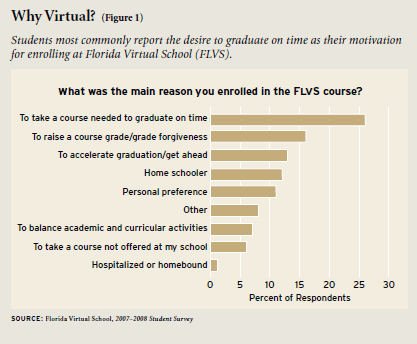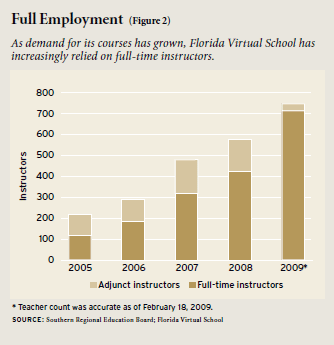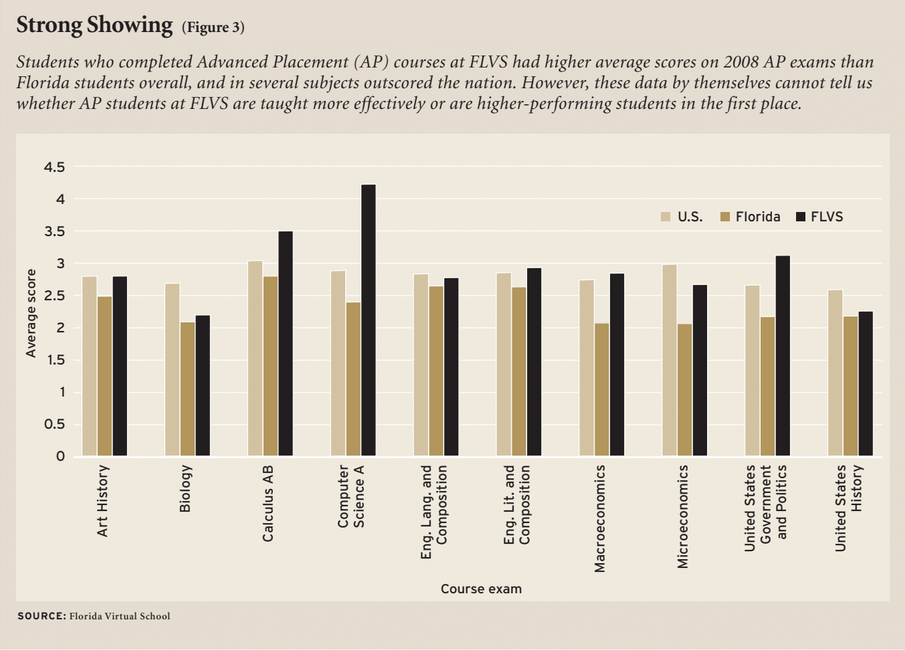Education reform often appears a zero-sum battle , one that pits crusaders demanding accountability and choice against much of the traditional education establishment, including teachers unions. The political skirmishes in Florida, including court fights over vouchers and charter schools, and ongoing struggles over a parade of different merit pay plans for teachers, give credence to the standard portrayal.
But state-run Florida Virtual School (FLVS), a decade-old public education experiment, departs from this conventional script. This most radical of choice based schools—where students and teachers never meet in physical classrooms and state funding flows on a performance-based, demand-driven model—has largely avoided the political and legal tangles that have stymied other reform efforts. And, free from the geographic constraints and facilities costs of traditional schools, FLVS has grown rapidly, scaling up to match the considerable demand for the school’s courses. In the 2008–09 school year, approximately 84,000 students will complete 168,000 half-credit courses, a 10-fold increase since 2002–03.
To accomplish this rare feat, the school has adroitly walked a fine line. It has built a distinct educational philosophy, approach, and culture. At the same time, it has maintained its identity as a public school and remains part of the system. This unique positioning, far enough outside to do business in a different way yet sufficiently inside the system to avoid political backlash, has been a key element in the school’s success. Mark Pudlow, spokesperson for the Florida Education Association, the teachers union that has fought pitched battles against many of Florida’s recent initiatives, acknowledges the result of Florida Virtual School’s approach: “[It] never developed the kind of mistrust that tends to be associated with other reform ideas.” Savvy leadership, strong political support, and a series of well-timed decisions around growth have helped FLVS become the country’s most successful virtual school, and perhaps one of its most important reform stories as well.
School on Demand
FLVS is a supplemental virtual school: most students attend brick-and-mortar schools and take FLVS courses in addition to their traditional classes. While the vast majority of FLVS students come from district schools (82 percent in 2007-08), the school is open to charter, private, and home-schooled students (see “Virtual Schools,” forum , Winter 2009).Much of the school’s recent growth has been driven by minority enrollments. Between June 2007 and July 2008, African-American enrollments grew by 49 percent, Hispanic enrollments by 42 percent, and Native American enrollments by 41 percent. Students enroll for a variety of reasons, but most come to fulfill graduation requirements, make up credits for missed or failed classes, or take Advanced Placement (AP) and other courses that are not available at their physical school (see Figure 1).

The FLVS motto, “any time, any place, any path, any pace,” emphasizes the school’s flexible and mastery-based approach to learning. Here, the content remains constant, but the time required—be it 16, 18, or 22 weeks—adjusts. Students at FLVS choose an accelerated, traditional, or extended pace for a particular course, taking extra time if needed to review and receive additional guidance on lessons or move through a course at a quicker pace than is typical. Moreover, FLVS students don’t have to wait for the semester to begin; they can choose the month in which they would like to start.
While its courses are virtual, FLVS strives for highly personalized instruction. The school employs more than 715 fulltime and 29 adjunct teachers—all Florida-certified and “highly qualified” under the federal No Child Left Behind law. Depending on the course, teachers use a variety of methods to engage students, including live one-to-one or small group virtual whiteboard sessions, asynchronous discussion, and even a new experimental, immersive online game for an American history course. Given the school’s flexible pacing, there isn’t a set class size, but full-time teachers are limited to 150 students each and individualized feedback is extensive. Instructors are expected to respond to student questions and provide comments on assignments within 24 hours. In addition, teachers phone students at least monthly, many times using oral assessments to ensure that students’ work is their own. Via the online course site, teachers post syllabi, readings, assignments, and other course materials.
Non-Adversarial Relationships
FLVS’s “inside the system” status originated in 1995 in efforts to develop Internet-based high-school programs in two Florida counties, Alachua (Gainesville) and Orange (Orlando). Both districts launched pilot programs and then formed an alliance to compete for state grant funding. In August 1997, FLVS began as Florida High School, with 77 course enrollments.
Nicholas Gledich, supervisor of Orange County’s initial program (he now serves as chief operating officer of Orange County Schools and is an FLVS trustee), recalls that from the beginning the school made a concerted effort to build relationships with a wide range of constituencies. While there was strong initial interest from home-schooling families, he says, it was important “to reach a diverse group of students” and establish “personal contact with districts and schools.”
Julie Young, who at the time worked for Gledich and is now CEO of FLVS, points to another important, early decision that helped set the precedent for a nonadversarial relationship with traditional district schools. Rather than become a diploma-granting institution and directly compete with traditional high schools, FLVS chose to supplement the brick-and-mortar high school. Instead of offering a full-time program that drew students away from traditional settings, the program focused on filling curricular gaps and expanding access to additional courses and learning opportunities. Young says the decision was “a huge deal.” We didn’t steal students from traditional schools; we “gave kids back to their schools in good shape.”
The grant-based funding mechanism provided early capacity-building funds, allowing FLVS to establish its courses, faculty, and credibility. Importantly, funds flowing to FLVS were over and above those received by traditional schools. Traditional high schools did not lose funds when students opted to take classes with FLVS. “If we went after FTE [regular school funding] we would be putting our head in the lion’s cage,” says Frank Brogan, Florida’s commissioner of education at the time of the school’s founding and later, in 2000, lieutenant governor under Jeb Bush. The fights begin “when you go after people’s money.”
Success Pays
From 1997 to 2003, FLVS enjoyed impressive growth, from the initial 77 course enrollments to more than 12,000. The school’s funding continued on a year-to-year appropriation, but strong political support in the governor’s office, the state department of education, and key legislative committees ensured that total funding rose from $1.3 to $6.9 million in the same time frame.
While FLVS’s political support was impressive, the annual appropriations funding mechanism not only was risky—it was subject to year-to-year budget decisions—but also essentially capped growth. And, despite the strong grant funding, the school could not keep up with student demand. In the summer of 2002, 8,000 students were on FLVS waiting lists after traditional summer school classes fell victim to budget cuts. The school decided it was time to seek a permanent funding mechanism through inclusion in the state’s school funding formula. Not only had the school proved highly effective and popular, but it had also grown large enough to develop its own political constituency, serving students from across Florida’s legislative districts.
In 2003, the Florida legislature voted to establish a performance-based funding model for the school. Under this model, the school’s funding is based on students’ successful completion of their courses, a step that places far more pressure on FLVS to ensure its students’ success than exists in traditional public school systems. Florida funds six credits per high-school student per year, so each time a student successfully completes a one-credit course, FLVS receives one-sixth of its per-pupil funding level ($1,054 per credit for 2008–09). Brogan calls this act an “absolute statement that the program had arrived.” This critical legislative action established the school as a permanent component of the state’s funding formula, providing stable and predictable funding outside of the yearly legislative allotment.
For the first time, this action also put FLVS in competition for funding with traditional school systems. “We would have preferred that it would have been funded outside the FEFP [Florida Education Finance Program],” said Ruth H. Melton, the director of legislative relations for the Florida School Boards Association, in a June 2003 EducationWeek article reporting on the legislation. Despite this opposition, FLVS was only a minor irritation among a number of controversial education reform programs. Melton concluded, “school boards are less concerned about losing funding to the virtual school than to the various voucher programs.” Former Florida governor Jeb Bush, reflecting on the legislative action, echoed Melton’s sentiment: “[At the time] we were doing so many different things that were provocative, this didn’t seem as radical.”
According to state rules, a student’s full-time school may not deny access to courses offered by FLVS. Taken together, the performance-based funding model and school choice provisions provide incentives for FLVS to be responsive to student, parent, and educational needs, an alignment not commonly found among district-run schools. Since there are no barriers to enrollment and funding is not capped at a preset amount, FLVS can increase its revenue by enrolling additional students and ensuring that those students successfully complete courses.
“Part of what Florida did is set it up in a way that gave direct access to parents and students, but structurally left kids enrolled in their district. [This has enabled] Florida to reach scale,” explains Barbara Dreyer, president and CEO of Connections Academy, a for-profit, full-time virtual school provider and partner of FLVS. “Many other states are caught in a catch-22: [Their programs] do not have enough scale so they are not cheap, but because they are not cheap they can’t get to scale.”
New Challenges

Despite FLVS’s success and national recognition—in December 2008 Florida governor Charlie Crist accepted a plaque from the Center for Digital Education recognizing Florida as the top provider of virtual education in the nation—the school still faces a number of operational and political challenges. The school is experiencing staggering growth; in the eight months from July 2008 to February 2009, it hired more than 300 new full-time teachers (see Figure 2). After a long period of extremely solid support in Tallahassee, the state’s executive and legislative leaders have begun to turn over.
The school was surprised at the end of 2007 when key state senate committee leaders convened a two-day workshop to hear from a variety of additional virtual school vendors, researchers, and district officials. While every legislator and speaker at the hearing expressed strong admiration and support for FLVS’s programs, it was clear that FLVS was no longer driving the agenda.
In 2008, spurred by a stated desire to increase school choice, but also partly motivated by fiscal concerns and vendor lobbying, the legislature voted to change the state’s other virtual school provisions that regulated full-time programs. In addition to FLVS’s supplemental programs, the state had contracted with two private providers, the similarly named Florida Virtual Academy, run by K12, Inc., and Florida Connections Academy, to offer fully online, fulltime, statewide virtual school programs for elementary- and middle-school students. The new law phased out the statewide programs, mandating that beginning in the 2009–10 school year, each Florida school district must develop its own offering or contract with a provider to offer a K–8 full-time online school option.
FLVS had to scramble quickly to respond. While the legislation did not directly impact FLVS’s supplemental programs or funding, it presented another, possibly more dangerous, issue. With 67 districts mandated to begin their own online programs and funding incentives for these districts to contract with low-cost providers and pocket the difference, FLVS feared that virtual education would be tainted by low-quality programs. Over the past five years, the school had watched as a number of other states, such as Colorado and Pennsylvania, conducted audits and investigations to root out mismanaged programs, casting doubt on quality programs in the process.
FLVS did not serve elementary-school students and operated on a supplementary basis. But the school already had “franchise” relationships with eight Florida counties, including Broward (Fort Lauderdale), Dade (Miami), and Hillsborough (Tampa). Under this agreement, the counties’ district schools use their own teachers in conjunction with FLVS’s courses and technology platform to offer online courses. For instance, in Broward County, the district offers a full-time alternative high-school program. These districts were mandated to begin K–8 full-time programs, but FLVS could only offer courses in 6th through 12th grade.
Faced with the possibility of being a nonplayer and not necessarily in a position to start its own program, FLVS decided to partner. The school issued an open solicitation for proposals and developed a partnership with private Connections Academy to jointly solicit and run K–8 programs for Florida school districts. Dreyer, when asked about the partnership, notes FLVS’s strong national reputation and the credibility it brings to her company.
Christopher McGuire, new principal at Broward Virtual School, an FLVS franchisee, continues the school’s philosophy of operating both within and outside of the system: “This is a healthy alternative to the conventional school model…we’re competing on a different plane: ‘Come to Broward Virtual School if the traditional model is not working for you.’”
A Winning Strategy
More than a decade after the school’s founding, Brogan recognizes the narrow path that FLVS has navigated between accommodation and confrontation. “Education has a unique ability to fend off and co-opt reform, drag it into a cul-de-sac and strangle it.” At the other extreme, “reformers can become such zealots. What is a great idea is lost in the translation of zealot status, lost in a wash of defensiveness.”
Bush, Brogan, and Gledich are all quick to point out that despite the school’s political support, it would not have succeeded without consistent leadership and a high-quality program. Former governor Bush says that a “poor quality product would have failed.” While much more research is needed to understand the effectiveness of virtual schooling for students in K–12, the small body of research available points to no significant differences in student performance in online courses versus face-to-face learning. At FLVS, the early evidence, including scores from its students’ AP exams, is positive (see Figure 3).

While it is still too early to determine the ultimate effect of FLVS on public schooling in Florida, the program’s growth is evidence that its political strategy has succeeded. Quietly, without the polarizing rhetoric or bruising battles of other reform efforts, the school has expanded options for students. For a virtual school, that’s a concrete achievement.
Bill Tucker is managing director at Education Sector


